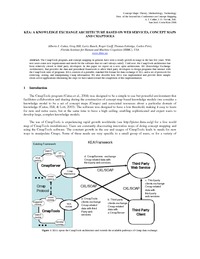KEA: A Knowledge Exchange Architecture Based on Web Services, Concept Maps and CMAP ToolsZu finden in: Second International Conference on Concept Mapping, 2006
 |
 |
 Diese Seite wurde seit 7 Jahren inhaltlich nicht mehr aktualisiert.
Unter Umständen ist sie nicht mehr aktuell.
Diese Seite wurde seit 7 Jahren inhaltlich nicht mehr aktualisiert.
Unter Umständen ist sie nicht mehr aktuell.
 Zusammenfassungen
Zusammenfassungen
 The CmapTools program, and concept mapping in general, have seen a steady growth in usage in the last few years. With new users come new requirements and needs for the software that we can’t always satisfy. Until now, the CmapTools architecture has been relatively closed to third party developers. In this paper we report on a new open architecture, KE (Knowledge Exchange Architecture), that provides the data and procedural framework to allow third party developers to design programs that interact with the CmapTools suite of programs. KEA consists of a portable, standard file format for data exchange (CXL), and a set of protocols for retrieving, storing, and manipulating Cmap information. We also describe how KEA was implemented and provide three sample client-server applications illustrating the steps we have taken toward the completion of this implementation.
The CmapTools program, and concept mapping in general, have seen a steady growth in usage in the last few years. With new users come new requirements and needs for the software that we can’t always satisfy. Until now, the CmapTools architecture has been relatively closed to third party developers. In this paper we report on a new open architecture, KE (Knowledge Exchange Architecture), that provides the data and procedural framework to allow third party developers to design programs that interact with the CmapTools suite of programs. KEA consists of a portable, standard file format for data exchange (CXL), and a set of protocols for retrieving, storing, and manipulating Cmap information. We also describe how KEA was implemented and provide three sample client-server applications illustrating the steps we have taken toward the completion of this implementation. Dieses Konferenz-Paper erwähnt ...
Dieses Konferenz-Paper erwähnt ...
 Begriffe KB IB clear | Client-ServerClient-Server
,  Cmap Tools
, Concept MapConcept Map
, Concept Mapping SoftwareConcept Mapping Software
, GraphViz Cmap Tools
, Concept MapConcept Map
, Concept Mapping SoftwareConcept Mapping Software
, GraphViz
|
 Dieses Konferenz-Paper erwähnt vermutlich nicht ...
Dieses Konferenz-Paper erwähnt vermutlich nicht ... 
 Nicht erwähnte Begriffe | dot, neato |
 Tagcloud
Tagcloud
 Volltext dieses Dokuments
Volltext dieses Dokuments
 |  KEA: A Knowledge Exchange Architecture Based on Web Services, Concept Maps and CMAP Tools: Artikel als Volltext ( KEA: A Knowledge Exchange Architecture Based on Web Services, Concept Maps and CMAP Tools: Artikel als Volltext ( : :  , 95 kByte; , 95 kByte;  : :  2021-03-21) 2021-03-21) |
 Anderswo suchen
Anderswo suchen 
 Beat und dieses Konferenz-Paper
Beat und dieses Konferenz-Paper
Beat war Co-Leiter des ICT-Kompetenzzentrums TOP während er Dieses Konferenz-Paper ins Biblionetz aufgenommen hat. Die bisher letzte Bearbeitung erfolgte während seiner Zeit am Institut für Medien und Schule. Beat besitzt kein physisches, aber ein digitales Exemplar. Eine digitale Version ist auf dem Internet verfügbar (s.o.). Aufgrund der wenigen Einträge im Biblionetz scheint er es nicht wirklich gelesen zu haben. Es gibt bisher auch nur wenige Objekte im Biblionetz, die dieses Werk zitieren.









 Biblionetz-History
Biblionetz-History